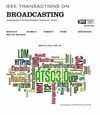复杂城市环境下DTMB信号定位
IF 4.8
1区 计算机科学
Q2 ENGINEERING, ELECTRICAL & ELECTRONIC
引用次数: 0
摘要
数字多媒体广播(DTMB)信号为无线定位提供了一个潜在的机会。本文研究了基于DTMB信号的到达时间(TOA)估计方法。对DTMB信号自相关特性的理论分析表明,DTMB信号具有定位特性。本文提出了一种基于DTMB信号的软件定义无线电(SDR)接收机进行定位。本文提出的SDR接收机的主要创新之处在于:1)在锁滞环(DLL)中采用窄功率早-负-晚延迟鉴别器(nEML),提高了多径电阻;2)提出了一种多状态融合滤波器,提高了环路滤波器的鲁棒性和精度;3)利用载波噪声无线电(C/N0)去除受严重非瞄准线(NLOS)环境影响的距离观测,从而降低低质量观测的影响。静场实验表明,TOA测距精度为1.666m。运动实验结果表明,DTMB接收机TOA测量值的均方根误差(RMSE)约为16m,定位结果的均方根误差(RMSE)约为17.7m,表明所设计的接收机在复杂城市环境中处理DTMB信号时能够提供相对可靠的定位结果。本文章由计算机程序翻译,如有差异,请以英文原文为准。
Localization With DTMB Signal Under Complex Urban Environments
Digital multimedia broadcast (DTMB) signal presents a potential opportunity for wireless localization. This paper studies the time of arrival (TOA) estimation based on the DTMB signal for localization. Theoretical analysis of the autocorrelation on the DTMB signal suggested that the DTMB signal has the characteristics for localization. In this paper, we propose software-defineded radio (SDR) receiver based on the DTMB signal for localization. The key innovations of the proposed SDR receiver are as follows: 1) employing a narrow Early-Minus-Late Power Delay Discriminator (nEML) in the delay-locked loop (DLL) to improve the multipath resistance; 2) proposing a multi-state fusion filter to improve the robustness and accuracy of the loop filter; 3) utilizing the carrier-to-noise radio (C/N0) to remove the range observation influenced by heavy non-line of sight (NLOS) environment, thereby reducing the impact of low-quality observations. The static field experiments show that the accuracy of TOA ranging is 1.666m. The motion experiment results show that the root mean square error (RMSE) of the TOA measurements from the DTMB receiver is about 16m, and the RMSE of the DTMB localization is about 17.7m, which shows that the designed receiver can provide relatively reliable localization results when processing DTMB signal in complex urban environments.
求助全文
通过发布文献求助,成功后即可免费获取论文全文。
去求助
来源期刊

IEEE Transactions on Broadcasting
工程技术-电信学
CiteScore
9.40
自引率
31.10%
发文量
79
审稿时长
6-12 weeks
期刊介绍:
The Society’s Field of Interest is “Devices, equipment, techniques and systems related to broadcast technology, including the production, distribution, transmission, and propagation aspects.” In addition to this formal FOI statement, which is used to provide guidance to the Publications Committee in the selection of content, the AdCom has further resolved that “broadcast systems includes all aspects of transmission, propagation, and reception.”
 求助内容:
求助内容: 应助结果提醒方式:
应助结果提醒方式:


